
Cup
An illustration of a cup designed by Euphronios, an ancient Greek vase painter and potter, active in…
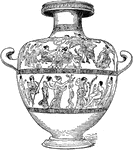
Hydria
A hydria is a type of Greek pottery used for carrying water. The hydria has three handles. Two horizontal…
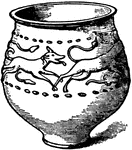
Jar
An illustration of a "jar of Castor ware with reliefs of a stag pursued by a hound, executed in semi-fluid…

Temple of Theseus
The Temple of Hephaestus and Athena Ergane, also known as the Hephaisteion or Theseion, is the best…

Echinus Molding
"A Capital of the Parthenon. - E, Echinus. In architecture, the convex projecting molding of eccentric…
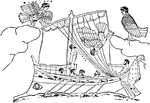
Ulysses and Sirens
From a hydria or vase painted by the "Siren Painter," this image shows Ulysses and the sirens from Homer's…

Encarpus
"In architecture, a sculptured ornament in imitation of a garland or festoon of fruits, leaves, or flowers,…
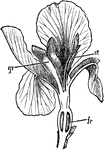
Iris
Iris is a genus of between 200-300 species of flowering plants with showy flowers. It takes its name…
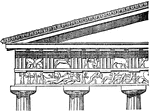
Doric Entablature
"Doric Entablature. E, entablature: a, epistyle or architrave; b, frieze; c, cornice." -Whitney, 1911
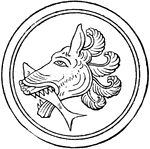
Episemon
Episema were used in Greece as a symbol for a country, region, or used on a shield or badge. This episemon…

Erechtheum
"The 'house of Erechtheus'; a temple of Ionic order on the Acropolis of Athens, noted as one of the…
Adderstongue
Lphioglossum (adder's-tongue) is a genus of about 25-30 species of Ophioglossales in the family Ophioglossaceae,…
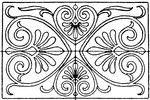
Greek Oblong Panel
The Greek oblong panel has a strict palmette decoration. It is found in the painted coffers (sunken…
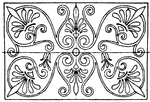
Greek Oblong Panel
The Greek oblong panel has a strict palmette decoration. It is found in the painted coffers (sunken…
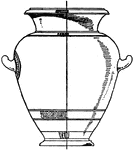
Greek Urn
This Greek urn is designed with painted clay. Typically used in funeral rites as a repository for the…

Greek Urn
This Greek urn is designed with painted clay. Typically used in funeral rites as a repository for the…
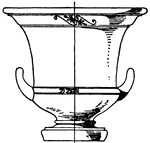
Greek Krater
This Greek krater is a type of antique vase that was typically used for mixing water and wine.
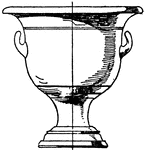
Greek Krater
This Greek krater is a type of antique vase that was typically used for mixing water and wine.
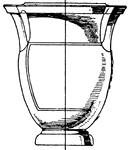
Greek Krater
This Greek krater has columnar handles. Its a type of antique vase that was typically used for mixing…
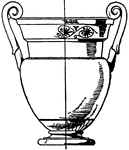
Greek Krater
This Greek Krater has volute handles that spiral upwards. Its a type of antique vase that was typically…
Greek Dish
This Greek dish is made out of yellow clay and painted in brown and red. It has a geometric design on…

Greek Dish
This Greek dish is made out of yellow clay and painted in red. It has a geometrical design ornamented…

Greek Dish
This Greek dish is a kylix used as a drinking cup. Made out of yellow clay, it is decorated in brown…

Antique Jar
This antique jar belongs to the later period of the red figure style used in Greek figural paintings.
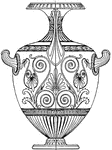
Greek Hydria
The Greek Hydria is used as a water-pot to carry water with from springs. Maidens carried it on their…

Greek Hydria
This Greek Hydria has a Kalpis form that is smooth and painted in black and red figures on the shoulder.…

Greek Hydria
This Greek Hydria is painted in black, reddish brown and white. Decorated of the highest class, the…
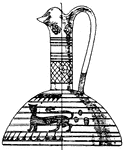
Greek Prochous
This Greek Prochous is in an archaic form and ornamentation, painted in clay. It was used as a sacrificial…
Greek Prochous
This Greek Prochous has a geometrical style made out of red clay and painted in black. It was used as…
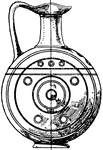
Greek Cyprian Vessel
This Greek Cyprian vessel has a geometrical style made out of yellow clay and painted in brown.
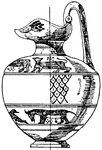
Greek Oinochoe
This Greek Oinochoe has an Asiatic style that is painted in yellow clay. It was used as a sacrificial…

Greek Vessel
This Greek vessel has a mouth that is pinched in on the sides. Made out of painted clay, this vessel…

Greek Vessel
This Greek vessel has a mouth that is pinched in on the sides. Made out of painted clay, this vessel…

Greek Vessel
This Greek vessel is made out of bronze. This vessel was partly used for secular and partly for religious…

Greek Lekythos
This Greek Lekythos is made of red clay and painted in black. The form is elongated and cylindrical,…

Greek Lekythos
This Greek Lekythos is made of red clay and painted in black. The form is elongated and cylindrical,…
Greek Lekythos
This Greek Lekythos is made of red clay and painted in black. The form is elongated and cylindrical,…

Greek Lekythos
This Greek Lekythos is made of red clay and painted in black. The form is elongated and cylindrical,…

Greek Lekythos
This Greek Lekythos is made of red clay and painted in black. The form is elongated and cylindrical,…

Greek Lekythos
This Greek Lekythos is made of red clay and painted in black. The form is elongated and cylindrical,…

Greek Lekythos
This Greek Lekythos is painted in black and white. The form is elongated and cylindrical, while the…

Greek Lekythos
This Greek Lekythos has an attic style. The form is elongated and cylindrical, while the neck is long…

Greek Lekythos
This Greek Lekythos has an attic style. The form is elongated and cylindrical, while the neck is long…

Greek Lekythos
This Greek Lekythos is made of red clay and painted in black. The form is elongated and cylindrical,…

Greek Lekythos
This Greek Lekythos is made of red clay and painted in black. The form is elongated and cylindrical,…

Greek Lekythos
This Greek Lekythos is made of red clay and painted in black. The form is elongated and cylindrical,…

Greek Lekythos
This Greek Lekythos is painted in black and white. The form is elongated and cylindrical, while the…
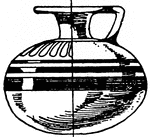
Greek Aryballos
This Greek Aryballos is a small spherical shape with a narrow neck. It is used as a perfume vase.

Greek Lekythos
This Greek Lekythos has an elongated and cylindrical form with a long neck. Its a type of Greek pottery…
![William Tyndale (sometimes spelled Tindall or Tyndall; (c. 1494 – 1536) was a 16th-century Protestant reformer and scholar who translated the Bible into the Early Modern English of his day. While a number of partial and complete Old English translations had been made from the seventh century onward, and Middle English translations particularly during the 14th century, Tyndale's was the first English translation to draw directly from Hebrew and Greek texts, and the first to take advantage of the new medium of print, which allowed for its wide distribution (it is worth mention that some scholars claim he made this translation from Latin[citation needed]). In 1535, Tyndale was arrested, jailed in the castle of Vilvoorde outside Brussels for over a year, tried for heresy and burnt at the stake.](https://etc.usf.edu/clipart/62000/62019/62019_w-tyndale_mth.gif)
William Tyndale
William Tyndale (sometimes spelled Tindall or Tyndall; (c. 1494 – 1536) was a 16th-century Protestant…
Exedra at the Street of Tombs in Assos
An exedra is a semicircular recess set into a building's facade. The exedra at the Street of Tombs in…

Trypanosoma
Trypanosoma are of the class kinetoplastida, a monophyletic group of unicellular parasitic protozoa.…

Trypanosoma
Trypanosoma are of the class kinetoplastida, a monophyletic group of unicellular parasitic protozoa.…
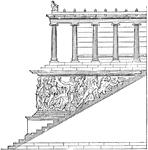
Frieze of Altar at Pergamon
The stairway of the great altar at Pergamon in Ancient Greece shows a frieze. A frieze is a sculpture…

Exterior of Walhalla
Walhalla, or German Temple of Fame and Honor is a neo-classical hall of fame located on the Danube River…

Glyptothek
The Glyptothek is a museum in Munich, Germany, which was commissioned by the Bavarian King Ludwig I…

Obverse and Reverse Sides of a Gazzetta
"Gazzetta of the Ionian islands, 1801. A small copper coin, worth about 3 farthings, made in Venice…

Daniel Refusing to Worship the Image
"But if not, be it known unto thee, O king, that we will not serve thy gods, nor worship the golden…

Bust of Homer
Homer is traditionally held to be the author of the ancient Greek epic poems the Iliad and the Odyssey,…
